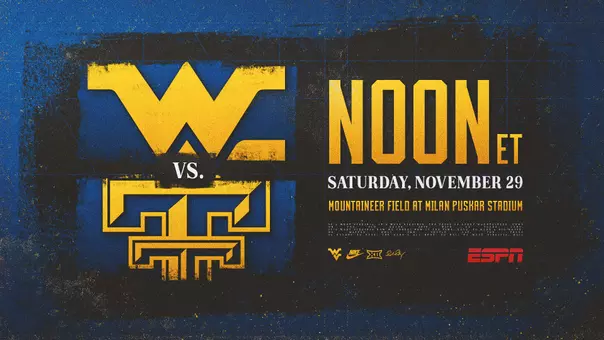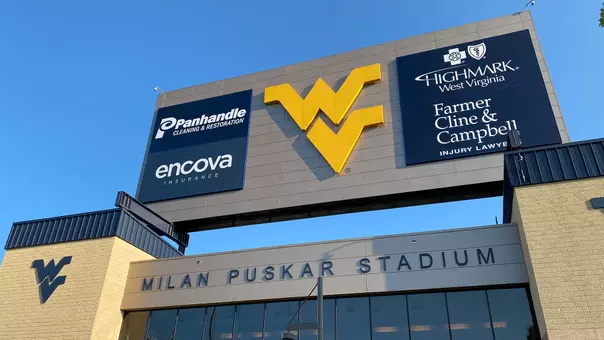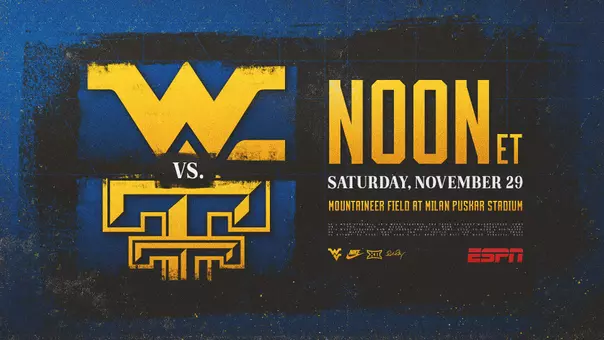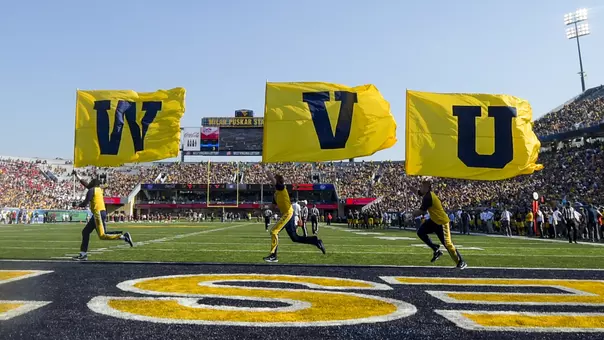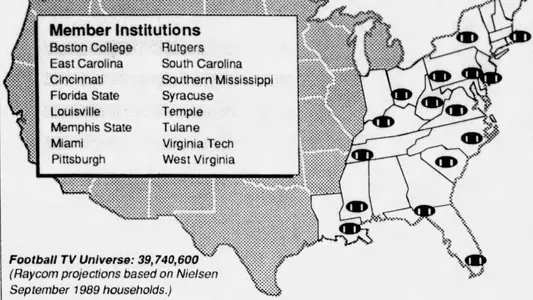
Idea of Super Conferences Not A New Phenomenon
July 05, 2022 04:15 PM | Football, Blog
MORGANTOWN, W.Va. – Having a collegiate sports conference spanning one side of the country to the other might sound a little strange, but it's far from being a novel concept.
Of course, I'm talking about the blockbuster announcement last week that longtime Pac-12 Conference stalwarts USC and UCLA plan to join the Big Ten Conference as early as 2024. That means USC and UCLA will be making cross-country trips to such places as Piscataway, New Jersey, State College, Pennsylvania, Columbus, Ohio, and East Lansing, Michigan.
When jet travel became common in the late 1950s, Admiral Tom Hamilton once proposed something similar for the remnants of the Pacific Coast Conference, which had endured an ugly breakup in 1958.
In 1959, Hamilton, formerly Pitt's head football coach and athletic director, took on the responsibility of reassembling the league, which eventually came to be known as the Pacific-8 Conference. What Hamilton proposed in the late 1950s, according to Keith Dunnavant in his 2004 book The Fifty-Year Seduction, was a super conference spanning the entire country and including some of the biggest names in college football at the time.
He encouraged those from USC, UCLA, Washington, Stanford and California to think big and pursue a configuration that included the three service academies, Notre Dame, Penn, Penn State, Duke, Georgia Tech and others.
This super conference could have also potentially included Pitt and West Virginia.
Hamilton, who commanded the aircraft carrier USS Enterprise during World War II, reasoned that jet air travel had shrunk the country to the point where geography was no longer an inhibiting factor to conference affiliation.
"It was going to be a monster football league," former Penn athletic director Jerry Ford once told Dunnavant.
Hamilton used his connections with the military to get the service academies interested, but someone in the Pentagon was against it and once the service academies backed out, Hamilton's plan collapsed. Hamilton was left with only a conference of five schools, which grew to eight a decade later when Washington State, Oregon and Oregon State joined and then to 10 when Arizona and Arizona State became members in 1978. The league added Colorado and Utah in 2011.
There were other super conference ideas.
The Southern Conference was once a 17-member monstrosity that encompassed five different states and the District of Columbia when WVU was invited to join in 1950.
However, this configuration lasted only three years before Clemson, Maryland, North Carolina, North Carolina State, Wake Forest, Duke and South Carolina left to form the Atlantic Coast Conference in 1953.
West Virginia and Virginia Tech were also hopeful of becoming members of the ACC a year later, but the league opted to add just the University of Virginia and limit its membership to eight schools. Morgantown's inaccessibility and lack of an adequate airport was the reason the ACC gave for not inviting WVU into the new league.
West Virginia could have been part of a 16-team super conference that was proposed in 1990. Raycom, the dominant television production company and syndicator at that time, pitched a massive configuration that would have morphed the Metro Conference and the Eastern football independents into one giant league encompassing more than a third of the television households in the country.
 Raycom spent six months putting together the proposal, taking into consideration such things as alumni bases, regional rivalries and institutional compatibility. What it suggested was a conference consisting of 16 football-playing schools with either two eight-team or four four-team divisions, similar to what the ACC and Pac-12 were also discussing at the time. In the spring of 1990, former WVU athletics director Ed Pastilong recalls going out to Dallas to sit in on Raycom's presentation.
Raycom spent six months putting together the proposal, taking into consideration such things as alumni bases, regional rivalries and institutional compatibility. What it suggested was a conference consisting of 16 football-playing schools with either two eight-team or four four-team divisions, similar to what the ACC and Pac-12 were also discussing at the time. In the spring of 1990, former WVU athletics director Ed Pastilong recalls going out to Dallas to sit in on Raycom's presentation.
"I remember the proposal being explored, but it was sort of left out there," Pastilong recalled.
Former Tennessee athletic director Dave Hart, Jr. was also at the meeting representing East Carolina.
"It would have changed the face of college athletics," Hart told Street & Smith's Sports Business Journal in 2011. "But the presidents just couldn't get their arms around it. There were several people who understood the vision and were really excited, but they were outnumbered by those who were just terrified of something so radical. Nobody had ever heard of a super conference before."
Raycom's plan called for a northern division consisting of Boston College, Cincinnati, Pitt, Rutgers, Syracuse, Temple, Virginia Tech and West Virginia.
The southern division was comprised of East Carolina, Florida State, Louisville, Memphis, Miami, South Carolina, Southern Miss and Tulane.
Penn State was originally part of the plan, but the Nittany Lions were already in the process of pursuing membership in the Big Ten.
The Metro's footprint would have accounted for more than 35% of the nation's TV households, putting it on par with the Big Ten, while maintaining traditional football rivalries such as Florida State-Miami and Pitt-West Virginia.
According to the sports publication, this new conference would "theoretically have commanded the largest TV dollars available because of its sheer size and the markets it covered." In 2011, Cedric Dempsey, the NCAA's former president and then a college consultant, said conference realignment taking place during that time period put the major football programs down a path toward creating their own division.
The notion of separation has been discussed by the power schools for decades, going back to the early 1970s when the NCAA held its so-called "economic conventions." During that time, everyone was voting on matters relative to football, former College Football Association president and Big 12 commissioner Chuck Neinas recalled in 2014. That meant San Jose State had a say in what Nebraska football was doing.
"To the NCAA's credit, it tried twice to restructure but failed," Neinas said. "Recognizing that, what happened was the group from the major conferences got together and said, 'Look, if we don't stay together as a lobbying group we will definitely be voted out.'"
What came of this was Divisions I, II and III, and then I-A, I-AA and I-AAA. Division I -A football programs eventually organized under the CFA umbrella led by Neinas.
"What drove the whole thing was the NCAA's inability to restructure," Neinas said, adding, "at one time we actually discussed Division IV. I'll never forget the late Bob James, who was the commissioner of the Atlantic Coast Conference, he said, 'Hell, we don't have to be Division I. We can be Division IV because we know who we are.'"
Judging from what is happening in college sports today, with the Big Ten soon to be comprised of schools from New Jersey to California and the SEC fortifying its stronghold on the south and southwest with Texas and Oklahoma set to join the league in 2025, the power schools are inching closer toward separating themselves completely.
The Big 12 is adding BYU, Houston, Cincinnati and Central Florida to its lineup in 2023, giving the conference a footprint of schools from Florida to Utah.
With the imminent departures of USC and UCLA, the western region is now in the midst of its biggest crisis since the Pacific Coast Conference disbanded in 1958. How that ends up is anyone's guess?
The ACC has a grant of rights that extends into the next decade, but a media rights deal that will also be significantly lower than what the Big Ten and the SEC are going to command. How will the ACC respond?
And then there is Notre Dame, which competes in the ACC in all sports except for football.
Whatever the Irish choose to do with their grid program is likely going to determine the direction college sports take in the coming decades.
Stay tuned.
Of course, I'm talking about the blockbuster announcement last week that longtime Pac-12 Conference stalwarts USC and UCLA plan to join the Big Ten Conference as early as 2024. That means USC and UCLA will be making cross-country trips to such places as Piscataway, New Jersey, State College, Pennsylvania, Columbus, Ohio, and East Lansing, Michigan.
When jet travel became common in the late 1950s, Admiral Tom Hamilton once proposed something similar for the remnants of the Pacific Coast Conference, which had endured an ugly breakup in 1958.
In 1959, Hamilton, formerly Pitt's head football coach and athletic director, took on the responsibility of reassembling the league, which eventually came to be known as the Pacific-8 Conference. What Hamilton proposed in the late 1950s, according to Keith Dunnavant in his 2004 book The Fifty-Year Seduction, was a super conference spanning the entire country and including some of the biggest names in college football at the time.
He encouraged those from USC, UCLA, Washington, Stanford and California to think big and pursue a configuration that included the three service academies, Notre Dame, Penn, Penn State, Duke, Georgia Tech and others.
This super conference could have also potentially included Pitt and West Virginia.
Hamilton, who commanded the aircraft carrier USS Enterprise during World War II, reasoned that jet air travel had shrunk the country to the point where geography was no longer an inhibiting factor to conference affiliation.
"It was going to be a monster football league," former Penn athletic director Jerry Ford once told Dunnavant.
Hamilton used his connections with the military to get the service academies interested, but someone in the Pentagon was against it and once the service academies backed out, Hamilton's plan collapsed. Hamilton was left with only a conference of five schools, which grew to eight a decade later when Washington State, Oregon and Oregon State joined and then to 10 when Arizona and Arizona State became members in 1978. The league added Colorado and Utah in 2011.
There were other super conference ideas.
The Southern Conference was once a 17-member monstrosity that encompassed five different states and the District of Columbia when WVU was invited to join in 1950.
However, this configuration lasted only three years before Clemson, Maryland, North Carolina, North Carolina State, Wake Forest, Duke and South Carolina left to form the Atlantic Coast Conference in 1953.
West Virginia and Virginia Tech were also hopeful of becoming members of the ACC a year later, but the league opted to add just the University of Virginia and limit its membership to eight schools. Morgantown's inaccessibility and lack of an adequate airport was the reason the ACC gave for not inviting WVU into the new league.
West Virginia could have been part of a 16-team super conference that was proposed in 1990. Raycom, the dominant television production company and syndicator at that time, pitched a massive configuration that would have morphed the Metro Conference and the Eastern football independents into one giant league encompassing more than a third of the television households in the country.
 Raycom spent six months putting together the proposal, taking into consideration such things as alumni bases, regional rivalries and institutional compatibility. What it suggested was a conference consisting of 16 football-playing schools with either two eight-team or four four-team divisions, similar to what the ACC and Pac-12 were also discussing at the time. In the spring of 1990, former WVU athletics director Ed Pastilong recalls going out to Dallas to sit in on Raycom's presentation.
Raycom spent six months putting together the proposal, taking into consideration such things as alumni bases, regional rivalries and institutional compatibility. What it suggested was a conference consisting of 16 football-playing schools with either two eight-team or four four-team divisions, similar to what the ACC and Pac-12 were also discussing at the time. In the spring of 1990, former WVU athletics director Ed Pastilong recalls going out to Dallas to sit in on Raycom's presentation."I remember the proposal being explored, but it was sort of left out there," Pastilong recalled.
Former Tennessee athletic director Dave Hart, Jr. was also at the meeting representing East Carolina.
"It would have changed the face of college athletics," Hart told Street & Smith's Sports Business Journal in 2011. "But the presidents just couldn't get their arms around it. There were several people who understood the vision and were really excited, but they were outnumbered by those who were just terrified of something so radical. Nobody had ever heard of a super conference before."
Raycom's plan called for a northern division consisting of Boston College, Cincinnati, Pitt, Rutgers, Syracuse, Temple, Virginia Tech and West Virginia.
The southern division was comprised of East Carolina, Florida State, Louisville, Memphis, Miami, South Carolina, Southern Miss and Tulane.
Penn State was originally part of the plan, but the Nittany Lions were already in the process of pursuing membership in the Big Ten.
The Metro's footprint would have accounted for more than 35% of the nation's TV households, putting it on par with the Big Ten, while maintaining traditional football rivalries such as Florida State-Miami and Pitt-West Virginia.
According to the sports publication, this new conference would "theoretically have commanded the largest TV dollars available because of its sheer size and the markets it covered." In 2011, Cedric Dempsey, the NCAA's former president and then a college consultant, said conference realignment taking place during that time period put the major football programs down a path toward creating their own division.
The notion of separation has been discussed by the power schools for decades, going back to the early 1970s when the NCAA held its so-called "economic conventions." During that time, everyone was voting on matters relative to football, former College Football Association president and Big 12 commissioner Chuck Neinas recalled in 2014. That meant San Jose State had a say in what Nebraska football was doing.
"To the NCAA's credit, it tried twice to restructure but failed," Neinas said. "Recognizing that, what happened was the group from the major conferences got together and said, 'Look, if we don't stay together as a lobbying group we will definitely be voted out.'"
What came of this was Divisions I, II and III, and then I-A, I-AA and I-AAA. Division I -A football programs eventually organized under the CFA umbrella led by Neinas.
"What drove the whole thing was the NCAA's inability to restructure," Neinas said, adding, "at one time we actually discussed Division IV. I'll never forget the late Bob James, who was the commissioner of the Atlantic Coast Conference, he said, 'Hell, we don't have to be Division I. We can be Division IV because we know who we are.'"
Judging from what is happening in college sports today, with the Big Ten soon to be comprised of schools from New Jersey to California and the SEC fortifying its stronghold on the south and southwest with Texas and Oklahoma set to join the league in 2025, the power schools are inching closer toward separating themselves completely.
The Big 12 is adding BYU, Houston, Cincinnati and Central Florida to its lineup in 2023, giving the conference a footprint of schools from Florida to Utah.
With the imminent departures of USC and UCLA, the western region is now in the midst of its biggest crisis since the Pacific Coast Conference disbanded in 1958. How that ends up is anyone's guess?
The ACC has a grant of rights that extends into the next decade, but a media rights deal that will also be significantly lower than what the Big Ten and the SEC are going to command. How will the ACC respond?
And then there is Notre Dame, which competes in the ACC in all sports except for football.
Whatever the Irish choose to do with their grid program is likely going to determine the direction college sports take in the coming decades.
Stay tuned.
Texas Tech Game Uniform Reveal
Thursday, November 27
United Bank Playbook: Texas Tech Preview
Wednesday, November 26
WRES: Rider Recap
Wednesday, November 26
Grayson Barnes | Nov. 25
Tuesday, November 25
